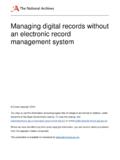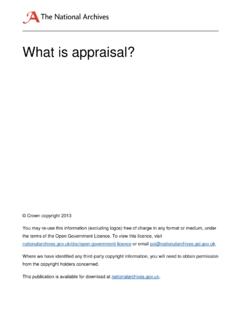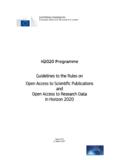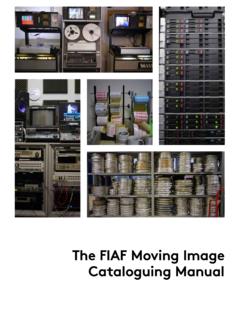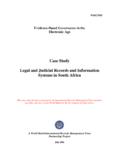Transcription of Document Digitization (Scanning) Standards - US EPA
1 INFORMATION Standards Document Digitization ( scanning ) Standards EPA Classification No.: CIO CIO Approval Date: 08/04/2015 CIO Transmittal No.: 15-009 Review Date: 08/04/2018 Issued by the EPA Chief Information Officer, Pursuant to Delegation 1-19, dated 07/07/2005 Document Digitization ( scanning ) Standards 1. PURPOSE To establish Standards for capturing digitized (scanned) content from paper and microform Agency documents and records in Agency content repositories or other designated digital storage environments. The Standards are designed to enhance the efficiency of Agency Digitization efforts and ensure that the quality of digitized documents meets intended uses. 2. SCOPE AND APPLICABILITY The Standards cover Digitization efforts across the Agency and apply to all EPA programs, regions, laboratories and offices. The Standards may also be used by owners of existing systems and applications that are currently digitizing documents within the scope of their operating authority ( , the Superfund Enterprise Management System, the Federal Docket Management System, the Correspondence Management System, etc.)
2 The Standards are intended to supplement other EPA information management policies, procedures and Standards . They focus primarily on operations for digitizing documents and records for delivery to Agency Document /records management applications. Some of the Standards may also be relevant to and considered when initially capturing and managing electronic information. 3. AUDIENCE The audience for the Standards includes all EPA organizations, officials and employees, as well as contractors, grantees and other agents of EPA that digitize Agency-owned paper-based or microform based records and documents. 4. BACKGROUND Several forces within the federal government are uniting to spur Digitization . Drivers for Digitization include the increased need for transparency and accessibility to information, the desire for enhanced mobility, and the desire to reduce the physical footprint of government office space.
3 Other drivers for Digitization include recent Presidential Memoranda and Directives from the National Archives and Records Administration (NARA) and the Office of Management and Budget (OMB) requiring that permanent records be managed electronically by 2019. Page 1 of 14 Document Digitization ( scanning ) Standards EPA Classification No.: CIO CIO Approval Date: 08/04/2015 CIO Transmittal No.: 15-009 Review Date: 08/04/2018 Benefits from the Standards include: Productivity improvement due to enhanced access to Agency records/documents; Reduction in the time and effort required to search for documents and records needed for a variety of regulatory and mission-related reasons; Decrease in the number of filing errors and the volume of duplicate content; Reduction in and better management of the overall volume of hard-copy (paper) information; Easier data sharing among information systems across the enterprise; and, Enhanced identification, sharing and use of Agency information resources by EPA s information customers and stakeholders.
4 The electronic management of digitized documents and records will also result in subsequent, reductions in the costs associated with paper-based documents and records. The Standards are thus designed to: Support the migration from hard-copy/paper-based documents to electronic documents; Integrate and standardize the Digitization process as part of the records life cycle; Leverage existing Agency investments in the EPA Enterprise Architecture ( , Documentum and its enterprise storage environment, scanners, etc.), Enterprise Content Management (ECM) systems such as the Correspondence Management System (CMS), Federal Docket Management System (FDMS) and Superfund Enterprise Management System (SEMS), and Enterprise Information Management (EIM); Serve as a framework into which additional program-specific Standards and workflows can be incorporated, based upon the needs of the business units; and Establish the basic standard business practices necessary to satisfy the requirements of the Federal Rules of Evidence, the Federal Records Act, and other authorities, policies and procedures under which the Agency must operate, such as NARA and known best practices.
5 5. AUTHORITY Clinger-Cohen Act (also known as Information Technology Management Reform Act of 1996) (Pub. L. 104-106, Division E) Paperwork Reduction Act of 1980, as amended by the Paperwork Reduction Act of 1995 (44 Chapter 35) Government Paperwork Elimination Act of 1998 (Pub. L. 105-277, Title XVII) United States vs. Russo, 480 1228, 1239 (6th Cir. 1973) Presidential Memorandum: Managing Government Records, November 28, 2011 Presidential Memorandum: Building a 21st Century digital Government, May 23, 2012 Executive Order Making Open and Machine Readable the New Default for Government Information, May 9, 2013 NARA/OMB Directive M-12-18: Managing Government Records, August 24, 2012 OMB Circular No. A-130: Management of Federal Information Resources OMB Memorandum M 10-06: Open Government Directive, December 8, 2009 OMB Memorandum M-13-13: Open Data Policy - Managing Information as an Asset May 9, 2013 Page 2 of 14 Document Digitization ( scanning ) Standards EPA Classification No.
6 : CIO CIO Approval Date: 08/04/2015 CIO Transmittal No.: 15-009 Review Date: 08/04/2018 CIO 2130 (formerly ): Accessible Electronic and Information Technology Standards , Procedures, and Guidance (PDF) April 5, 2006, ( ) 6. Standards EPA programs, regions, laboratories and offices are directed to: Use the Digitization Standards for capture of hard-copy documents and records in Agency content repositories or other designated storage environments ( , CMS, FDMS), where use does not jeopardize existing standard business practices; and Incorporate the Digitization Standards into documented standard operating procedures (SOPs) to ensure consistency across the Agency and establish the framework for legally-defensible standard business practices for Digitization . For additional information on Digitization SOPs, please refer to the related EPA Information Directive Digitization ( scanning ) Procedures.
7 The parameters should inform the equipment selection, as well as the decision to perform the work at EPA or through a contract vehicle. Hardware ( brand neutral ) Standards A. Low volume scanner standard The standard designates the acceptable scanner device for low volume ( , incidental/infrequent use for small-batch jobs < 25 pages) applicable for the scanning of standard office paper materials only: Desktop/stand-alone flatbed scanners; Multi-function copier/printer machines; All-in-one scanners/printers; and Wide-format scanners for oversized documents, up to 34 in. x 44 in. ( , page measurement Standards ISO-A0 and ANSI-E). B. High volume scanner standard The standard designates the acceptable scanner devices for high volume ( , frequent use for large-batch jobs >25 pages) applicable for the scanning of standard office paper materials only: 1,000 page/hour minimum throughput; Compatible with Enterprise Capture Software standard (see software standard below); ISS- and Twain-driver compatible; Native (on board), or compatible with, Kofax Virtual Re-Scan (VRS ) quality-enhancing production software, or alternatively, the Captiva /Input Accel Image Quality Checks feature; Sheet size capability from in.
8 X in. ( , page measurement standard ISO-A8) up to 11 in. x 17 in. ( , page measurement Standards ISO-A3 and ANSI-B); Duplex (2-side scanning ) capability; and Color, gray-scale and monochrome capability. Page 3 of 14 Document Digitization ( scanning ) Standards EPA Classification No.: CIO CIO Approval Date: 08/04/2015 CIO Transmittal No.: 15-009 Review Date: 08/04/2018 C. Film digitizers standard ( , microform, microfilm, slides, etc.) The standard directs users to address the following characteristics that may influence the Digitization approach or affect the digital image quality: The type and volume of the materials to be digitized; Text quality and clarity on the microfilm; The quality of the original capture of the film (lack of focus, uneven lighting, page curvature, gutter shadows, etc.); Variations in density between exposures; The reduction ratio of the film; Resolution and the ability to detect detail on the film; and The condition of the film itself (scratches, etc.)
9 Digitizing and capture software Standards The Standards here apply only to new acquisitions or upgrades to the software already in use in the Agency. They are not intended to require wholesale replacement of software used now or in the past. D. Low volume digitizing and software applications standard Stand-alone (non-networked) usage: o Manufacturer-supplied capture software; o Manual submission of output to Enterprise Capture Software (see below) o Network-attached usage: Integrated with Enterprise Capture Software (see below) E. High volume digitizing and software standard Enterprise Capture (high volume, as defined in the high volume scanner standard above) network-attached usage: EMC Captiva (InputAccel ) (Note: The software is a native component of the Agency s Documentum Enterprise License.) Kofax Capture (Multiple server-level installations across the Agency) F. Analog or film based digitizing and software standard ( , microform, microfilm, slides, etc.)
10 Manufacturer-supplied capture software Page 4 of 14 Document Digitization ( scanning ) Standards EPA Classification No.: CIO CIO Approval Date: 08/04/2015 CIO Transmittal No.: 15-009 Review Date: 08/04/2018 Content digitized file format Standards G. PDF/A-1 file format standard (Portable Document Format/Archive) Preferred format for documents that are primarily textual in nature; Image-over-text content indexing ( , optical character recognition, or OCR); Optimized for Internet/Web streaming; NARA preferred specification for transfer to Archive: ISO 19005-1:2005 electronic Document file format for long-term preservation part 1: Use of PDF (PDF/A-1): ( ) Not the preferred output for non-networked scanning of textual documents where that output should be passed on to Enterprise Capture software for processing (see the TIFF file format standard below) Not the preferred output for non-textual materials such as graphics, maps and photographs (see the JPEG file format standard below) H.










